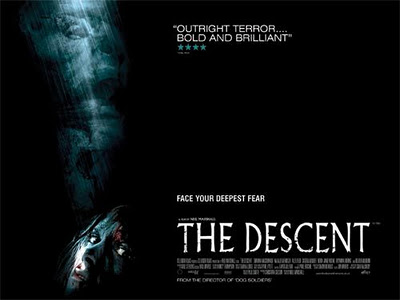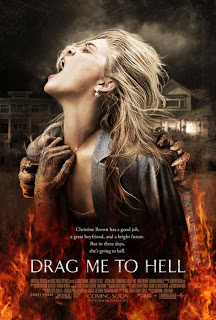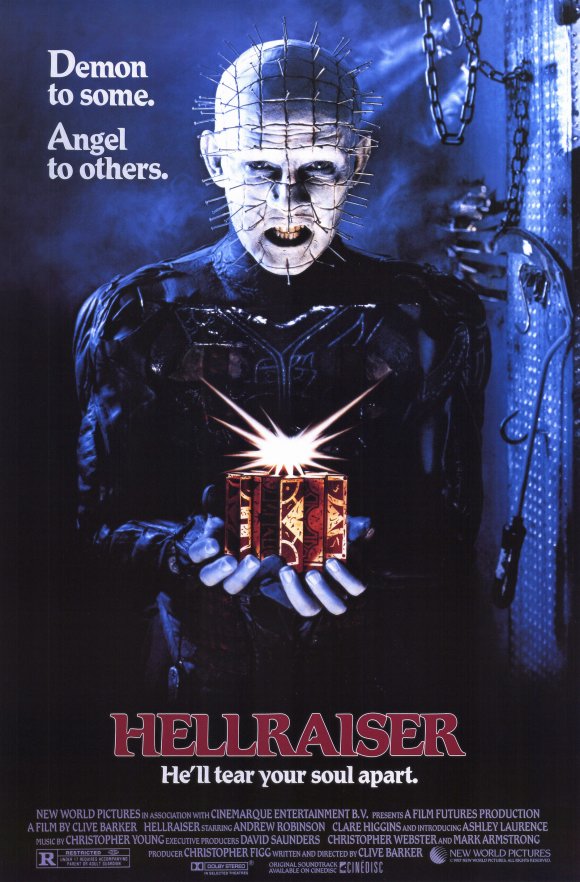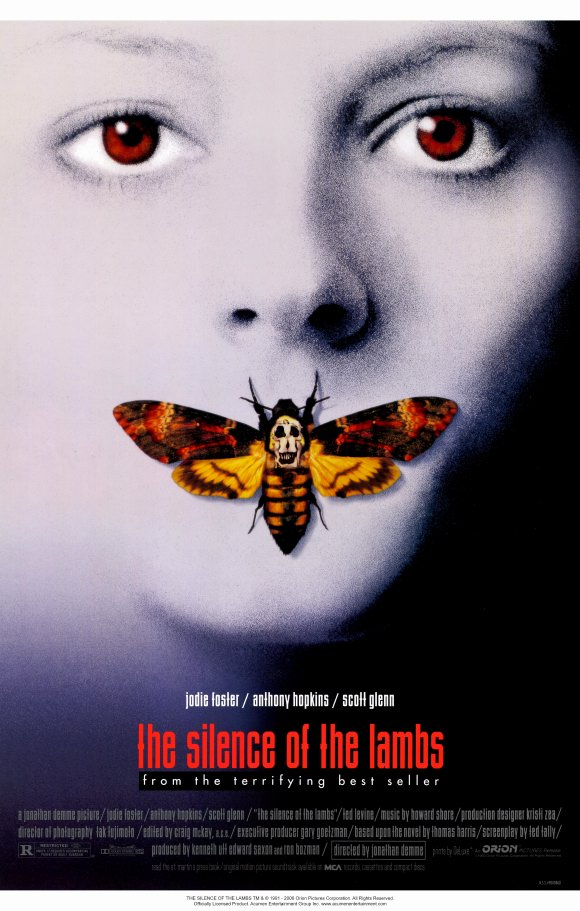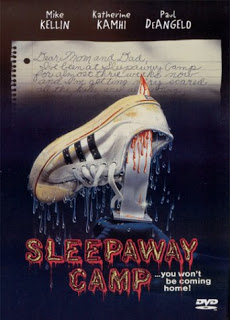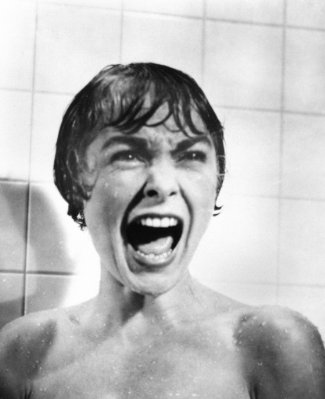When I first heard of The Descent, around the time of its 2006 theatrical release, it was described to me as “a movie about a bunch of lesbians who go into a cave and there are monsters.”
Tag: Women in Horror
Horror Week 2011: The Blair Witch Project
 |
| The Blair Witch Project (1999) |
Viewers might hope that with its unconventional approach, shoestring budget, and status as the first blockbuster powered by Internet buzz, The Blair Witch Project could offer horror fans something they haven’t seen before, specifically in terms of how women are represented. At first, the flick looks promising because it centers on a female lead in a position of authority. While it’s arguable whether The Blair Witch Project’s through-the-viewfinder conceit is actually innovative (cinephiles like to point to the correlations between Blair Witch and Man Bites Dog and Cannibal Holocaust), it’s safe to say that—in 1999, at least—no films with this particular conceit had enjoyed such widespread popularity. The presence of this conceit might account for the film’s success, coming as it did in the watershed era of reality television. Its lo-fi, DYI qualities lend the film a realism that at that time felt new and potentially persuasive. While the ensuing years have brought us further variations on the motif—Cloverfield, Paranormal Activity, and Super 8, among others—it’s also become much easier to see how The Blair Witch Project, for all its putative realism, renders unduly harsh judgments on its female lead.
Horror Week 2011: Drag Me to Hell
This review, written by Stephanie Rogers, was originally published in June 2009.
But, I ask you, can a film that sacrifices a goat and a kitten really be taking itself so seriously?
 Everything that exists in this movie is a stereotype: the skinny blonde who used to be fat and now refuses to eat carbs, the skinny blonde’s self-hatred and rejection of her farm-girl roots, the rich boyfriend who will undoubtedly help her escape it all, his rich and consequently vapid, overbearing parents who want their son to marry a nice upper-class girl, the patriarchal workplace where the skinny blonde gets sent for sandwiches by her male coworkers, the jerk who sells out a coworker in order to get promoted, the brown-skinned psychics who hold hands around a table and chant in an attempt to invoke The Evil Spirit, the gypsy, obviously, and not least importantly, the fucking goat sacrifice.
Everything that exists in this movie is a stereotype: the skinny blonde who used to be fat and now refuses to eat carbs, the skinny blonde’s self-hatred and rejection of her farm-girl roots, the rich boyfriend who will undoubtedly help her escape it all, his rich and consequently vapid, overbearing parents who want their son to marry a nice upper-class girl, the patriarchal workplace where the skinny blonde gets sent for sandwiches by her male coworkers, the jerk who sells out a coworker in order to get promoted, the brown-skinned psychics who hold hands around a table and chant in an attempt to invoke The Evil Spirit, the gypsy, obviously, and not least importantly, the fucking goat sacrifice.
The point is: it’s hard to play the I-hated-this-movie-because-of-the-blah-blah-“insert offensive stereotype”-game, when the film unapologetically turns everyone into a caricature.
Drag Me To Hell is about a young woman, Christine (played by Alison Lohman), who makes a questionable decision in an effort to get promoted at the bank where she works. She refuses to give a third extension on a woman’s mortgage loan, and in doing so, the woman, Mrs. Sylvia Ganush (played by Lorna Raver), could potentially lose her home. The twist? Christine could’ve given her the extension. But she chose not to. Instead, Christine wanted to prove to her boss that she’s a tough, hard-nosed, business savvy go-getter, and therefore certainly more qualified than her ass-kissing male coworker (who she’s in the process of, ahem, training) to take over the assistant manager position.
Then, as luck would have it, all hell breaks loose.
 For the next hour and a half, these women go all testosterone and maniacally kick each other’s asses. This isn’t an Obsessed-type ass-kicking, where Beyonce Knowles beats the crap out of Ali Larter over, gasp, a man! and where all that girl-on-girl action plays like late-night Cinemax porn for all the men in the house. (Read Sady Doyle’s excellent review of it here). No, this is strictly about two women, one old, gross, and dead, the other young, gorgeous, and alive, trying to settle a score. Christine wants to live, dammit! And Mrs. Ganush wants to teach Christine a lesson for betraying her in favor of corporate success!
For the next hour and a half, these women go all testosterone and maniacally kick each other’s asses. This isn’t an Obsessed-type ass-kicking, where Beyonce Knowles beats the crap out of Ali Larter over, gasp, a man! and where all that girl-on-girl action plays like late-night Cinemax porn for all the men in the house. (Read Sady Doyle’s excellent review of it here). No, this is strictly about two women, one old, gross, and dead, the other young, gorgeous, and alive, trying to settle a score. Christine wants to live, dammit! And Mrs. Ganush wants to teach Christine a lesson for betraying her in favor of corporate success!
I vacillated between these two women throughout the movie, hating one and loving the other. After all, Christine merely made a decision to advance her career, a decision that a man in her position wouldn’t have had to face (because he wouldn’t have been expected to prove his lack of “weakness”). If her male coworker had given the mortgage extension, I doubt it would’ve necessarily been seen as a weak move. And even though Christine made a convincing argument to her boss for why the bank could help the woman (demonstrating her business awareness in the process), her boss still desired to see Christine lay the smack-down on Grandma Ganush. I sympathized with her predicament on one hand, and on the other, I found her extremely unlikable and ultimately “weak” for denying the loan. (Check out the review at Feministing for another take on this.)
Mrs. Ganush, though, isn’t your usual villain. She’s a poor grandmother, who fears losing her home. She literally gets down on her knees and begs Christine for the extension. Sure, she hacks snot into a hankie and gratuitously removes her teeth here and there, but hey, she’s a grandma, what’s not to love? Other than, you know, evil.
 I love that this movie is about two women who are both arguably unlikeable to the point where you hope they either both win or both die. (The last time I remember feeling that way while watching a movie was probably during some male-driven cop/gangster drama. Donnie Brasco? American Gangster? Goodfellas? Do women even exist in those movies?) Everyone else is a sidekick, including the doe-eyed boyfriend (played by Justin Long), who basically plays the stand-by-your-(wo)man character usually reserved for women in every other movie ever made in the history of movies, give or take, like, three.
I love that this movie is about two women who are both arguably unlikeable to the point where you hope they either both win or both die. (The last time I remember feeling that way while watching a movie was probably during some male-driven cop/gangster drama. Donnie Brasco? American Gangster? Goodfellas? Do women even exist in those movies?) Everyone else is a sidekick, including the doe-eyed boyfriend (played by Justin Long), who basically plays the stand-by-your-(wo)man character usually reserved for women in every other movie ever made in the history of movies, give or take, like, three.
But at the same time, one could certainly argue that Christine’s unwillingness to help Mrs. Ganush, which results in Christine spending the next three days of her life desperately trying not to be dragged to hell, plays as a lesson to women: you can’t get ahead, regardless, so just stop trying. (Dana Stevens provides an analysis on Slate regarding this double-edged-sword dilemma that Christina finds herself in.)
 Some have also argued that Drag Me To Hell exists in the same vein as the Saw films: it’s nothing but torture porn and obviously antifeminist. Yes, it’s gory, with lots of nasty stuff going in and out of mouths (Freud?), but the villain gets her share, and Christine hardly compares to the traditional heroine of lesser gore-fests: for one, she’s strong, much stronger than the horror-girls who can’t seem to walk without falling down in their miniskirts, and for the most part, she makes life-or-death decisions on her own, growing stronger and more adept as she faces the consequences of those decisions.
Some have also argued that Drag Me To Hell exists in the same vein as the Saw films: it’s nothing but torture porn and obviously antifeminist. Yes, it’s gory, with lots of nasty stuff going in and out of mouths (Freud?), but the villain gets her share, and Christine hardly compares to the traditional heroine of lesser gore-fests: for one, she’s strong, much stronger than the horror-girls who can’t seem to walk without falling down in their miniskirts, and for the most part, she makes life-or-death decisions on her own, growing stronger and more adept as she faces the consequences of those decisions.
Perhaps most importantly, Christine isn’t captured by some sociopathic male serial killer and helplessly tortured in a middle-of-nowhere shed for five days. She trades blows with her attacker, and at one point, in pursuit of Mrs. Ganush, she even states that she’s about to go, “Get some.” (Ha.)
I personally read the film as an attempt to uphold the qualities our society traditionally categorizes as “feminine” characteristics: compassion, understanding, consideration, etc. I’m not suggesting that men don’t also exhibit these qualities, but when they do, they’re often considered weak and unmanly, especially when portrayed on-screen, which is demonstrated quite effectively when Christine confronts her male coworker about his attempts to sabotage her career; he bursts into tears in a deliberately pathetic played-for-laughs diner scene.
But it’s only when Christine rejects these qualities in herself (the sympathetic emotions she initially feels toward Mrs. Ganush), and consciously coaxes herself into adopting hard-nosed, traditionally “masculine” characteristics (which her male boss rewards her for), that she’s ultimately punished—and by another woman, no less. The question remains, though, is she punished for being a domineering corporate bitch, or is she punished for rejecting her initial response to help out? Regardless of the answer, the film makes a direct commentary on the can’t-win plight of women in the workplace, and, newsflash: it still ain’t pretty.
Watch the trailer here.
Horror Week 2011: Hellraiser
 |
| Hellraiser (1987) |
When people talk about classic horror movies, they’re almost always referring to the eighties which contained Nightmare on Elm Street, The Thing, and Child’s Play to name a few. Hellraiser, released in 1987, is no exception. While the movie lacks a lot of the high-tech special effects we’ve grown used to in contemporary cinema, the make-up in Hellraiser is impressively chilling. Although I’d seen the film several times prior (including all its sequels), I still found myself cringing and gagging as Frank emerged from the floorboards as little more than a slimy substance with bones.
“What’s the matter? It’s what you brought me here for, isn’t it?”
“I suppose so, yes.”
“So what’s your problem? Let’s get on with it.” And as Julia’s reluctance seems to grow, he growls, “You aren’t going to change your fucking mind, are ya?”
Tatiana Christian is a blogger at Parisian Feline, who writes about sexuality, gender and basically her thoughts on social justice and life. She previously contributed a review of Slumdog Millionaire to Bitch Flicks.
Horror Week 2011: The Sexiness of Slaughter: The Sexualization of Women in Slasher Films
Over the course of the series’ eight one-hour episodes, those skilled and sexy enough to command the screen survive. Those who don’t will “get the axe” until only one strong, seductive and stellar actress remains, earning the break-out role in “Saw VI” and the title of Scream Queen.
The season 1 winner, Tanedra Howard, won the chance to show audiences just how seductive and stellar she could look while being tortured.
As years passed, young audiences required that gruesome images become more intense and explicit for them to become scared…In 1978, a movie called Halloween not only sold more tickets than any other horror film, it broke all previous box-office records for any type of film made by an independent production company. Hollywood immediately tried to tap into the success of Halloween. Films such as Friday the 13th, Don’t Go In the House, Prom Night, Terror Train, He Knows You’re Alone, and Don’t Answer the Phone were all released in 1980. These movies, which are some of the first slasher films, were extremely successful. However, with their increasing popularity came strong criticism. Slasher films were condemned for frequently portraying vicious attacks against mostly females and for mixing sex scenes with violent acts.
This popular kill from Jason X involves scientist Andrea getting her face dunked in liquid nitrogen. While struggling with Jason, Andrea’s shit (half of what could be a sexy scientist Halloween costume) rides up revealing to the audience the bottom of her full breasts. While this small glimpse does not equate itself to the arousal of an all-out sex scene, it is intentional. From costuming to blocking, every aspect of the character’s femininity in this scene was meticulously plotted. The fact that filmmakers, audiences, and Maxim find a kill scene more enticing if the woman is sexy and almost shirtless speaks to the fact that modern horror films sexualize slaughter.
Social scientists have expressed concern over the negative effects that slasher films may have on audiences. In particular, exposure to scenes that mix sex and violence is believed to dull males’ emotional reactions to filmed violence, and males are less disturbed by images of extreme violence aimed at women (Linz, Donnerstein & Adams, 1989). These effects on male viewers are said to derive from “classical conditioning”.
Sapolsky and Molitor rebuff this idea, believing that the pairing of sex and violence does not occur often enough for classical condition to occur. However, they further state:
The concern over potential negative effects of exposure to slasher films remains. Possibly, depictions of violence directed at women as well as the substantial amount of screen time in which women are shown in terror may reduce male viewers’ anxiety. Lowered anxiety reduces males’ responses to subsequently-viewed violence, including violence directed at women. Accordingly, the desensitizing effects of slasher films may result from a form of “extinction” and not from classical conditioning.”
It appears that no matter how you slice it, this pairing, on unconscious level, does not leave viewers unaffected.
Horror Week 2011: The Silence of the Lambs
 |
| The Silence of the Lambs (1991) |
Horror Week 2011: Sleepaway Camp
 |
| Sleepaway Camp (1983) |
But Angela’s not deceiving everybody because she’s a trans* person. She’s deceiving everybody because she’s a (fictional) trans* person created by cissexual filmmakers. As Drakyn points out, the trans* person who’s “fooling” us on purpose is a myth we cissexuals invented. Why? Because we are so focused on our own narrow experience of gender that we can’t imagine anything outside it. We take it for granted that everyone’s gender matches the sex they were born with. With this assumption in place, the only logical reason to change one’s gender is to lie to somebody.
Horror Week 2011
Call for Writers: Women in Horror Films
 |
| Some scary-looking pumpkins. |
Rosemary’s Baby – 1968
Open Water – 2003
The Mist – 2007
The Descent – 2005
Nightmare on Elm Street – 1984
A Tale of Two Sisters – 2003 (Taiwan)
The Silence of the Lambs – 1991
Pan’s Labyrinth – 2006
The Exorcist – 1973
Audition – 1999
Halloween – 1978
Alien – 1979
The Ring – 2002
Rec – 2007
Ju-on – 2000
Jennifer’s Body – 2009
Ginger Snaps – 2000
May – 2002
Slumber Party Massacre – 1982
Carrie – 1976
The Company of Wolves – 1984
Teeth – 2007
Day of the Woman – 1978
Scream – 1996
Gothika – 2003
When a Stranger Calls – 1979
The Others – 2001
The Orphanage – 2007
The Roommate – 2011
Single White Female – 1992
Mother’s Day – 1980
Insidious – 2011
Red Riding Hood – 2011
The Ward – 2011
Carnival of Souls – 1998
Die! Die! My Darling! – 1965
What Lies Beneath – 2000
The Blair Witch Project – 1999
Sorority Row – 2009
Case 39 – 2010
Paranormal Activity – 2007
Movie Preview: Sorority Row
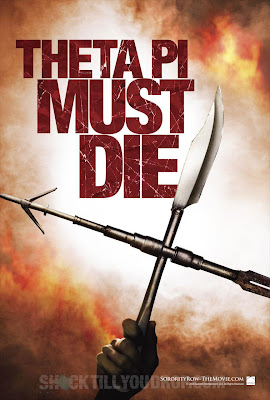 imdb synopsis: College juniors Cassidy, Jessica, Claire, Ellie, and Megan are sorority sisters sworn to trust, secrecy and solidarity, no matter what. But their loyalty is tested when a prank at a raucous house party goes terribly wrong and Megan ends up brutally murdered. Rather than confess to the crime and risk destroying their bright futures, the girls agree to hide the bloody corpse and keep their secret forever.
imdb synopsis: College juniors Cassidy, Jessica, Claire, Ellie, and Megan are sorority sisters sworn to trust, secrecy and solidarity, no matter what. But their loyalty is tested when a prank at a raucous house party goes terribly wrong and Megan ends up brutally murdered. Rather than confess to the crime and risk destroying their bright futures, the girls agree to hide the bloody corpse and keep their secret forever.
And then they all get stalked by some mysterious killer in a hood (Scream) who knows their secret and sends them videos and pictures of their secret (I Know What You Did Last Summer and I Still Know What You Did Last Summer and … is there another one)?
What the hell? I realize this is a remake of the 1983 film The House on Sorority Row, but does every misogynistic horror film from 1983 really need a remake? Here’s what I’m betting on: gratuitous nudity, possibly in hot tubs, girl-on-girl hate, or, you know, murder. I’ll just stop there.
Look, let me be the first to admit that I don’t exactly have a high opinion of most sororities in general, especially given many of their well-known hazing techniques (body-shaming one another by circling “problem areas” in marker, etc). But this film will most certainly take on a they-all-deserve-to-die theme, with the audience identifying exclusively with the killer, as the killer picks off the girls in one hilarious bloodbath after another.
While a film like Mean Girls tries to take a decidedly feminist slant in the end, at least in the way it addresses the issue of female competition for men, female slut-shaming, and the subsequent abandonment of sisterhood (I have some problems with this film, but that’s for another post), a film like Sorority Row promises to use the idea of sisterhood as some kind of commentary on … what? Female incompetence?
Face it, when women get together man, I mean, watch the fuck out! You might, like, die!
Of course, we can’t ignore Carol J. Clover’s “Final Girl” theory. She argues in her book Men, Women and Chainsaws: Gender in the Modern Horror Film, that slasher films are obsessed with feminism in that they force male viewers to identify with the Final Girl, the one lone girl who doesn’t die, who gets her shit together, who kills the killer.
And all the men in the audience cheer!
I get that. And I like her theory. But I don’t have high hopes for this particular film to live up to her theory. As I said above, when these girls do a stupid, shitty thing, and one of their sorority sisters dies as a result, I suspect that a major element of you-deserve-what-you-get-haha-bitches will overtake any potential empowering “Final Girl” resolution. I hope I’m wrong.
